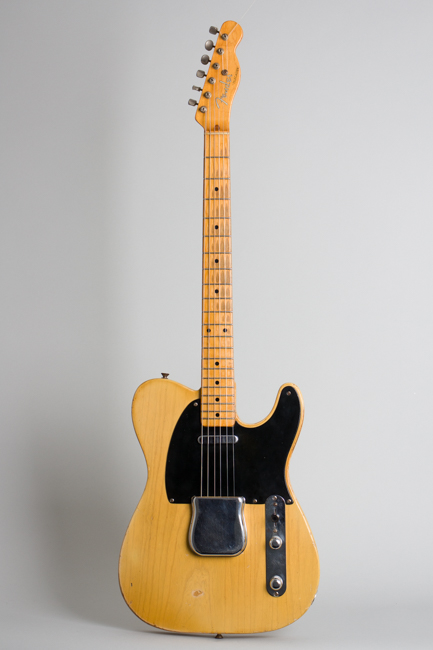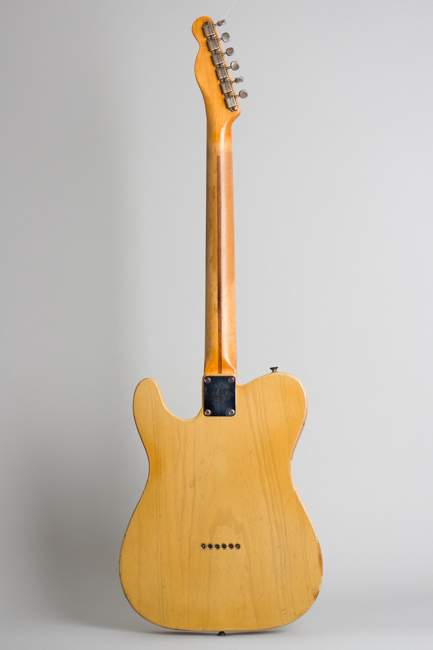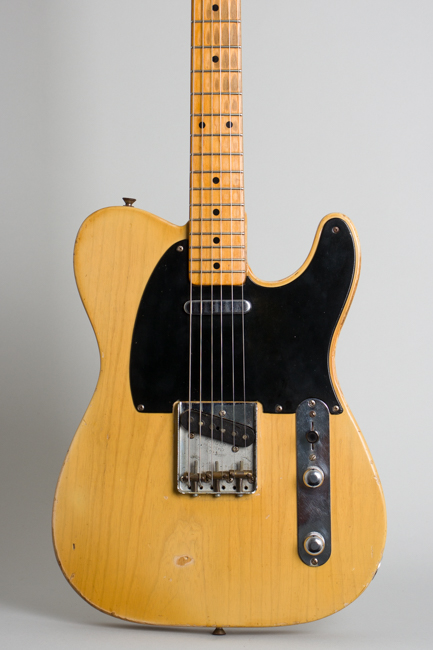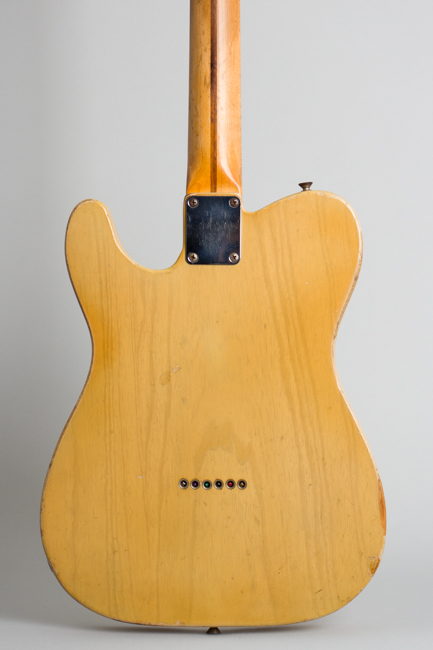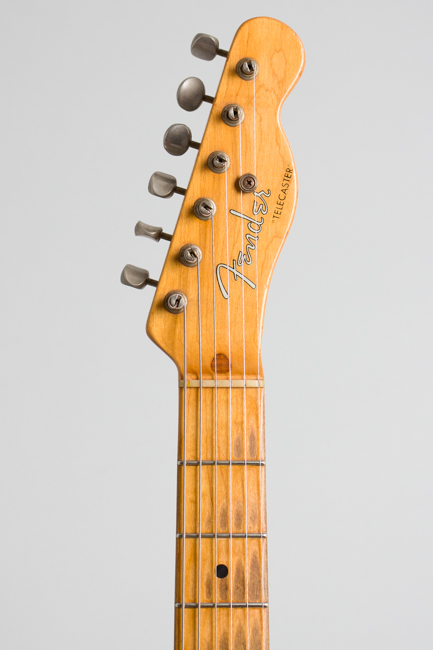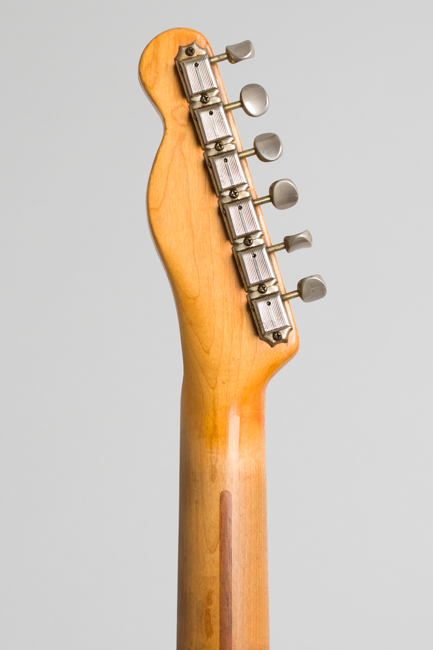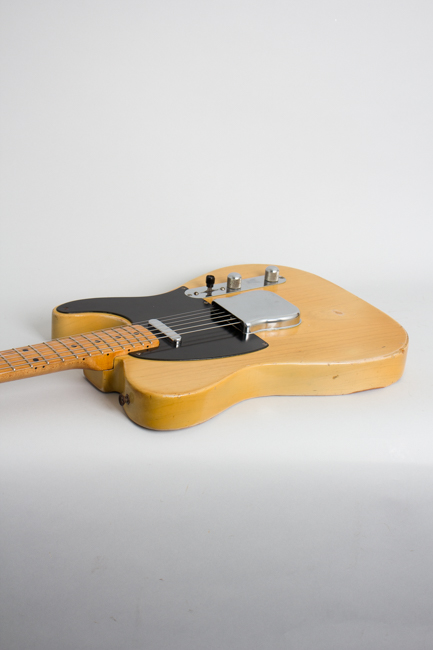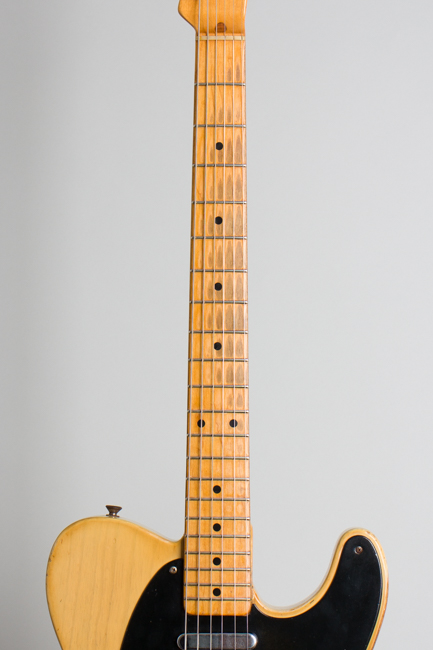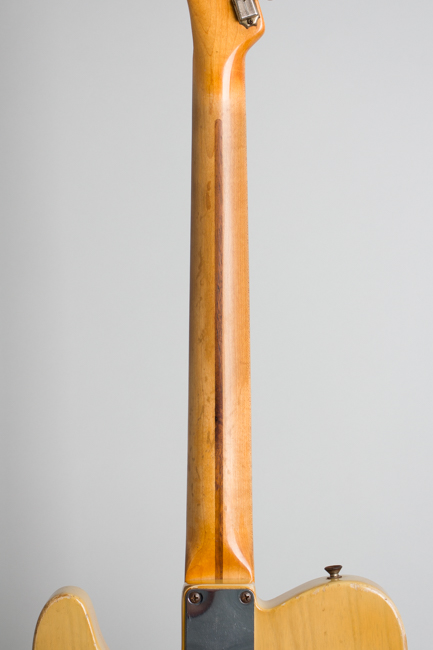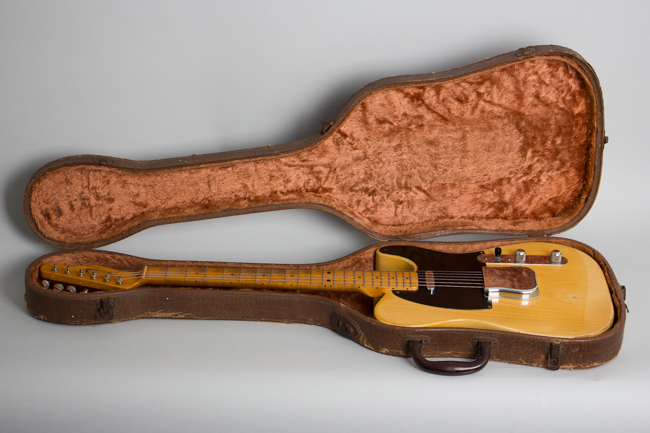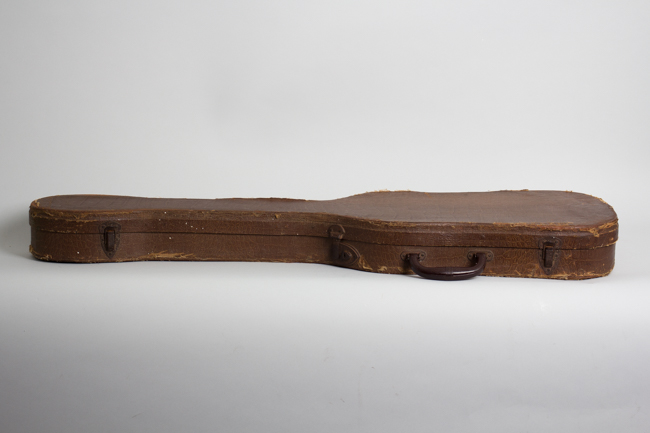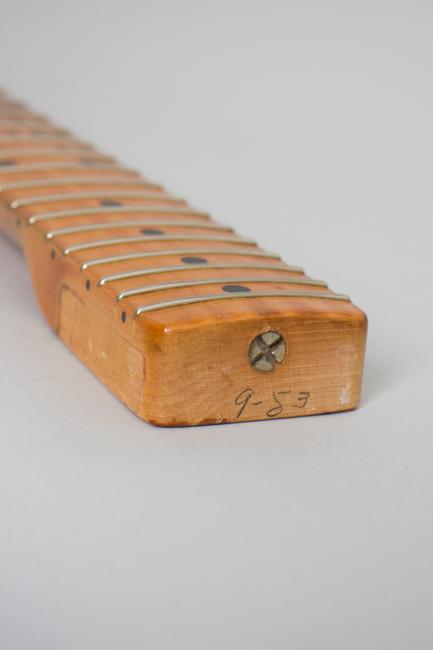Fender Telecaster Solid Body Electric Guitar (1953)
This item has been sold.
Item # 11495
Prices subject to change without notice.
Fender Telecaster Model Solid Body Electric Guitar (1953), 6.87 lbs., made in Fullerton, California, serial # 4915, Blonde lacquer finish, ash body, maple neck, original brown hard shell case.
This is a somewhat played-in but still beautiful "Blackguard" Telecaster -- the guitar that put Leo Fender's company on the map. It was built just as the summer of 1953 ended, right after the company moved from their original cinder-block factory to a larger facility in Fullerton, California and retains all the classic '52 Tele features. The one-piece maple neck, aged "butterscotch" blonde-finished ash body, lacquered black fiber pickguard, brass bridge saddles, and of course the original black-bobbin hand wound pickups with a sound for the ages are all present and accounted for.
This guitar carries serial number 4915 stamped into the bridgeplate, with the neck dated 9-53 in pencil on the heel. The body also carries a date mark of 9-53 in the neck pocket, in red pencil. At this point Fender employees were just starting to mark only the month of fabrication without the exact date. Both pot date codes are at least partially soldered over; the pots are original. The masking tape note in the control cavity indicates the guitar was wired up Gloria on September 24th 1953; these dates are more closely grouped than many early Fenders. Perhaps Fender sales had a run of orders in early fall '53 the factory was pushing to complete, after the move briefly interrupted production.
This guitar has been played but not abused since it was shipped out in fall 1953 remaining nicely original overall. The maple neck has been neatly refretted with wire a bit taller than the original spec. It is very comfortable neck with a round-backed profile, a bit less rounded "throat" in the lower positions than some '53s, with more material dressed away on the sides. The screws are pretty much all Phillips-head as is customary for 1953; the bridge has its brass saddles notched under the outside ends to make lower action setting easier, another 1953 refinement.
The early-style wiring rig; unlike many, has never been re-wired to the "modern" Telecaster switching scheme. As originally set up there is a "deep bass" capacitor on the neck pickup in switch position #1; position #2 is the neck pickup in normal mode, and #3 is the bridge pickup with a master tone control. The neck and bridge pickups can be combined by carefully lodging the selector between positions #2 and #3, which works better on this guitar than some we have had.
For many, 1952-3 are the classic Telecaster years, with the same look and feel of the earliest Fender Broadcaster and "No-Casters" from 1950-51 but more consistent production standards. Before the introduction of the Stratocaster in 1954 the Tele and Precision Bass were the company's most innovative products, already causing a revolution in playing styles and shaking up the guitar industry in a big way. The Telecaster was totally unique in look, feel, and sound, and became instantly popular, particularly with country players.
Many of the artists most since associated with "blackguard" Teles have used this year's models including Roy Buchanan, Danny Gatton, James Burton, Keith Richards, Albert Lee, and Red Volkaert. The "butterscotch" blonde ash body and maple neck are subtly changed from the earlier examples, with the neck profile being slightly sleeker than "Broadcaster" standards and the finish having a slight halo effect around the edges.
Some players and collectors consider the 1953 Telecaster the most desirable example of the model. In his authoritative and beautiful book "The Blackguard" author Nachos Banos references this and states "There is something really magical about these mid-'53 butterscotch finishes". Early Fender Telecasters of this period are considered one of the most collectable and historic of all electric guitars, and this is a very fine example.
Overall length is 38 3/4 in. (98.4 cm.), 12 5/8 in. (32.1 cm.) wide at lower bout, and 1 3/4 in. (4.4 cm.) in depth, measured at side of rim. Scale length is 25 1/2 in. (648 mm.). Width of nut is 1 5/8 in. (41 mm.).
Overall this is a very nice example of a '53 Blackguard showing some typical wear and tear but no notable alteration except the refret. The original owner appears to have kept this guitar for decades, and used it extensively but also cared for it carefully. The internal components all appear original, the "mud cap" itself is the correct value and period but not the style we are used to seeing. It looks like the neck pickup may have been re-potted somewhere along the line, a few solder joints appear redone. The bridge pickup looks untouched.
The thin lacquer body finish has ambered and checked lightly and shows typical dings, dents, and worn spots, especially to the edges as usual. The back upper edges has some deeply worn areas with a small amount of clearcoat applied long ago as protection. A larger ding on the top has been polished out a bit but these is no sign of added finish there. There are a couple of fairly small case lid dings on the upper edge of the top. The back has some dings, dents and scrapes, with a small buckle spot on the back having a spot of topical touchup. The pickguard may have had a thin added coat of lacquer sprayed over it long ago; this is not conspicuous. The lower back edges of the guard are slightly rounded down by the controls.
The finish on the back of the neck is smoothly worn down to the wood over much of its length, especially on the treble side. There are a few scattered dings and dents but nothing major. The fingerboard has a lot of wear through the finish lightly into the wood mostly in the lower positions and running up the treble side. Even with the refret there does not appear to have been any overspray done to the neck or fingerboard but if so most has been subsequently worn away. The bone nut appears later.
All hardware on the instrument is original, showing light typical wear. The bridge saddles and have some typical corrosion and discoloration but nothing is rusted hard and all adjustment screws are functional. The original "ashtray" bridge cover is present, with the previous owners' ID information etched into the underside; someone also added two strips of foam under the plate itself. The original owner also put his name, address and AFM affiliation on a paper piece taped to the body under the pickguard, also written on the underside of the neck plate. He also noted "bought new in December 1953" there!
Other than the frets and a few minor tweaks this instrument remains pretty much as it left Fullerton in fall 1953, with less wear from years of hard gigging behind it than many of these now show and none of the drastic modifications that befell way too many. It is a truly fantastic-sounding guitar, with a powerful bridge pickup that really sings. The guitar is still housed in the original shaped hard case, a major rarity in itself that has wear to the edges but is still solid. This is about the nicest '53 Tele we have had in a while, a splendid twang machine and serious piece of Fender -- and guitar -- history Overall Excellent - Condition.
This is a somewhat played-in but still beautiful "Blackguard" Telecaster -- the guitar that put Leo Fender's company on the map. It was built just as the summer of 1953 ended, right after the company moved from their original cinder-block factory to a larger facility in Fullerton, California and retains all the classic '52 Tele features. The one-piece maple neck, aged "butterscotch" blonde-finished ash body, lacquered black fiber pickguard, brass bridge saddles, and of course the original black-bobbin hand wound pickups with a sound for the ages are all present and accounted for.
This guitar carries serial number 4915 stamped into the bridgeplate, with the neck dated 9-53 in pencil on the heel. The body also carries a date mark of 9-53 in the neck pocket, in red pencil. At this point Fender employees were just starting to mark only the month of fabrication without the exact date. Both pot date codes are at least partially soldered over; the pots are original. The masking tape note in the control cavity indicates the guitar was wired up Gloria on September 24th 1953; these dates are more closely grouped than many early Fenders. Perhaps Fender sales had a run of orders in early fall '53 the factory was pushing to complete, after the move briefly interrupted production.
This guitar has been played but not abused since it was shipped out in fall 1953 remaining nicely original overall. The maple neck has been neatly refretted with wire a bit taller than the original spec. It is very comfortable neck with a round-backed profile, a bit less rounded "throat" in the lower positions than some '53s, with more material dressed away on the sides. The screws are pretty much all Phillips-head as is customary for 1953; the bridge has its brass saddles notched under the outside ends to make lower action setting easier, another 1953 refinement.
The early-style wiring rig; unlike many, has never been re-wired to the "modern" Telecaster switching scheme. As originally set up there is a "deep bass" capacitor on the neck pickup in switch position #1; position #2 is the neck pickup in normal mode, and #3 is the bridge pickup with a master tone control. The neck and bridge pickups can be combined by carefully lodging the selector between positions #2 and #3, which works better on this guitar than some we have had.
For many, 1952-3 are the classic Telecaster years, with the same look and feel of the earliest Fender Broadcaster and "No-Casters" from 1950-51 but more consistent production standards. Before the introduction of the Stratocaster in 1954 the Tele and Precision Bass were the company's most innovative products, already causing a revolution in playing styles and shaking up the guitar industry in a big way. The Telecaster was totally unique in look, feel, and sound, and became instantly popular, particularly with country players.
Many of the artists most since associated with "blackguard" Teles have used this year's models including Roy Buchanan, Danny Gatton, James Burton, Keith Richards, Albert Lee, and Red Volkaert. The "butterscotch" blonde ash body and maple neck are subtly changed from the earlier examples, with the neck profile being slightly sleeker than "Broadcaster" standards and the finish having a slight halo effect around the edges.
Some players and collectors consider the 1953 Telecaster the most desirable example of the model. In his authoritative and beautiful book "The Blackguard" author Nachos Banos references this and states "There is something really magical about these mid-'53 butterscotch finishes". Early Fender Telecasters of this period are considered one of the most collectable and historic of all electric guitars, and this is a very fine example.
Overall length is 38 3/4 in. (98.4 cm.), 12 5/8 in. (32.1 cm.) wide at lower bout, and 1 3/4 in. (4.4 cm.) in depth, measured at side of rim. Scale length is 25 1/2 in. (648 mm.). Width of nut is 1 5/8 in. (41 mm.).
Overall this is a very nice example of a '53 Blackguard showing some typical wear and tear but no notable alteration except the refret. The original owner appears to have kept this guitar for decades, and used it extensively but also cared for it carefully. The internal components all appear original, the "mud cap" itself is the correct value and period but not the style we are used to seeing. It looks like the neck pickup may have been re-potted somewhere along the line, a few solder joints appear redone. The bridge pickup looks untouched.
The thin lacquer body finish has ambered and checked lightly and shows typical dings, dents, and worn spots, especially to the edges as usual. The back upper edges has some deeply worn areas with a small amount of clearcoat applied long ago as protection. A larger ding on the top has been polished out a bit but these is no sign of added finish there. There are a couple of fairly small case lid dings on the upper edge of the top. The back has some dings, dents and scrapes, with a small buckle spot on the back having a spot of topical touchup. The pickguard may have had a thin added coat of lacquer sprayed over it long ago; this is not conspicuous. The lower back edges of the guard are slightly rounded down by the controls.
The finish on the back of the neck is smoothly worn down to the wood over much of its length, especially on the treble side. There are a few scattered dings and dents but nothing major. The fingerboard has a lot of wear through the finish lightly into the wood mostly in the lower positions and running up the treble side. Even with the refret there does not appear to have been any overspray done to the neck or fingerboard but if so most has been subsequently worn away. The bone nut appears later.
All hardware on the instrument is original, showing light typical wear. The bridge saddles and have some typical corrosion and discoloration but nothing is rusted hard and all adjustment screws are functional. The original "ashtray" bridge cover is present, with the previous owners' ID information etched into the underside; someone also added two strips of foam under the plate itself. The original owner also put his name, address and AFM affiliation on a paper piece taped to the body under the pickguard, also written on the underside of the neck plate. He also noted "bought new in December 1953" there!
Other than the frets and a few minor tweaks this instrument remains pretty much as it left Fullerton in fall 1953, with less wear from years of hard gigging behind it than many of these now show and none of the drastic modifications that befell way too many. It is a truly fantastic-sounding guitar, with a powerful bridge pickup that really sings. The guitar is still housed in the original shaped hard case, a major rarity in itself that has wear to the edges but is still solid. This is about the nicest '53 Tele we have had in a while, a splendid twang machine and serious piece of Fender -- and guitar -- history Overall Excellent - Condition.
